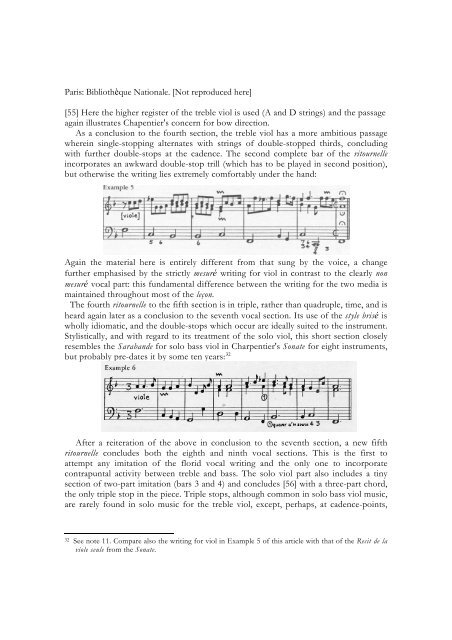You also want an ePaper? Increase the reach of your titles
YUMPU automatically turns print PDFs into web optimized ePapers that Google loves.
Paris: Bibliothèque Nationale. [Not reproduced here][55] Here the higher register of the treble viol is used (A and D strings) and the passageagain illustrates Chapentier's concern for bow direction.As a conclusion to the fourth section, the treble viol has a more ambitious passagewherein single-stopping alternates with strings of double-stopped thirds, concludingwith further double-stops at the cadence. The second complete bar of the ritournelleincorporates an awkward double-stop trill (which has to be played in second position),but otherwise the writing lies extremely comfortably under the hand:Again the material here is entirely different from that sung by the voice, a changefurther emphasised by the strictly mesuré writing for viol in contrast to the clearly nonmesuré vocal part: this fun<strong>da</strong>mental difference between the writing for the two media ismaintained throughout most of the leçon.The fourth ritournelle to the fifth section is in triple, rather than quadruple, time, and isheard again later as a conclusion to the seventh vocal section. Its use of the style brisé iswholly idiomatic, and the double-stops which occur are ideally suited to the instrument.Stylistically, and with regard to its treatment of the solo viol, this short section closelyresembles the Sarabande for solo bass viol in Charpentier's Sonate for eight instruments,but probably pre-<strong>da</strong>tes it by some ten years: 32After a reiteration of the above in conclusion to the seventh section, a new fifthritournelle concludes both the eighth and ninth vocal sections. This is the first toattempt any imitation of the florid vocal writing and the only one to incorporatecontrapuntal activity between treble and bass. The solo viol part also includes a tinysection of two-part imitation (bars 3 and 4) and concludes [56] with a three-part chord,the only triple stop in the piece. Triple stops, although common in solo bass viol music,are rarely found in solo music for the treble viol, except, perhaps, at cadence-points,32 See note 11. Compare also the writing for viol in Example 5 of this article with that of the Recit de laviole seule from the Sonate.
















